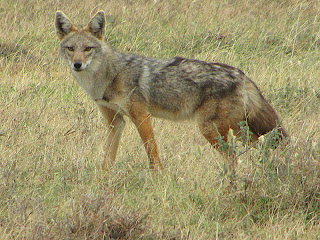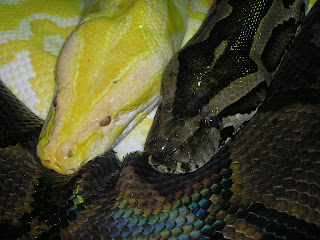I wrote this article for my J800 class last semester at the beginning of October. Unfortunately I wasn't able to get it published in any of the local papers when it was still timely. But, the nice thing about having a blog is that I can use it to publish pieces that don't get picked up elsewhere, so here you go...
A U.S. Geological Survey study has found that cyanotoxins in Midwest lakes emit odors, adding smell to the public’s arsenal against exposure to hazardous aquatic toxins.
Before you enter your local lake, stop and smell the water. A new study shows that lakes in the throes of a toxic algae bloom give off a characteristic scent that can warn people to stay away. According to the United States Geological Survey (USGS) the findings should help the public identify hazardous lakes based on their smell, reducing the instance of cyanotoxin-related illness.
“Cyanotoxins pose the largest hazard to human health during recreational activities, so public health is one of the motivations behind studies of these toxins,” said Jennifer Graham a researcher at the USGS’ Kansas Water Science Center, and lead researcher on the study.
Simply avoiding lakes with algae isn’t a realistic way for residents to stay safe because algae occurs naturally and is not usually harmful. According to Graham, residents need new ways to tell whether specific algae blooms contain toxic compounds. The researchers tested for chemical signatures that indicate the presence of odor, and found that cyanobacteria blooms give the water what Graham describes as a musty smell.
The study showed the odor consistently occurs when toxins are present, but toxins can occur without the odor. According to Graham this makes smell a useful indication that toxins are present, but not something the public can rely on with absolute certainty.
“Smell is something that anybody should be able to use, the human nose is very sensitive to the compounds produced by the cyanobacteria. It is musty and might smell like dirt and so that could be used to evaluate a situation,” said Graham. “From a recreational perspective it is useful because odor gives a cue that there might be something of concern going on in an area.”
Would your nose know?
While Graham maintains that the odors given off by toxic algae blooms are distinctive enough to identify a toxic bloom, some Madison residents have doubts.
University of Wisconsin-Madison (UW-Madison) sophomore Martin Feehan doesn’t think smell is a reliable way to identify cyanotoxin episodes in Wisconsin’s lakes. Feehan is president of Hoofer Scuba, a recreational group at UW that uses the lakes surrounding campus regularly.
“I think smell could be a good way, but it could also be misleading because the different smells in the lake could come from several sources,” said Feehan. According to Feehan, the decomposition of plant material or fish could easily cause earthy, musty smells at the lakes that could be confused with the toxin scent.
Feehan says participating in Hoofer Scuba has made him aware of cyanotoxins, but the group does not actively look for toxic blooms. Instead, they rely on notices from the Madison Department of Public Health. “We have warnings that go up at the boathouse if there are blooms,” said Feehan.
Todd Miller, a postdoctoral researcher at UW-Madison is wary of encouraging the public to sniff out cyanotoxins. Miller, who holds a doctorate in marine estuarine environmental sciences from the University of Maryland, College Park, has worked as a postdoctoral researcher in the laboratory of Trina McMahon since 2007.
“The study is intriguing and I think opens the door to potential new methods for early toxic bloom detection,” said Miller, in an email message. “But there are many sources of the odor compounds the researchers measured, and as the study shows toxins can be present in the water at dangerous levels even when the odor compounds are not present.”
According to Miller, smelling the lakes to identify the presence of toxins is unreliable. “It is probably not reasonable to expect the public to identify toxic or non-toxic waters based on smell,” said Miller. “I tell people to enjoy the lakes, but don’t swallow the water, pay attention to public warning signs by the health department and don’t enter the water if the lakes are closed to recreation.”
Graham says smell is not the only one way that the public should identify potentially toxic blooms, and advocates using multiple means to avoid exposure to cyanotoxins including visual cues (green or red tint to the water or scum floating on the water’s surface) and checking for warning notices before entering a lake.
A persistent problem
Cyanobacteria and the toxins they produce are a problem that has affected Midwest lakes for several years. According to the Global Lake Ecological Observatory Network and the UW-Center for Limnology nine beaches in Madison were closed due to cyanotoxins in July 2009, the largest cyanotoxin episode in Wisconsin that year.
According to Graham, cyanobacteria are microorganisms that occur naturally in aquatic ecosystems as part of algae blooms. Some of these blooms contain cyanobacteria, which can create toxic chemical compounds that can be dangerous.
The three main types of toxins are dermatoxins, which cause skin or respiratory reactions after direct contact; hepatotoxins, which are absorbed by the liver and cause gastroenteritis; and neurotoxins, which are absorbed by the central nervous system.
Though cyanobacteria exist naturally in lakes, according to Graham, the toxins they produce become problematic when they occur in increasingly large concentrations. This happens when algae the bacteria thrive on grow rapidly.
“Cyanobacteria blooms are a natural phenomenon, but they can be aggravated by human activities,” said Graham. These activities include land development that causes soil to erode and runoff from farms or landscaping that washes fertilizer and soil into lakes.
According to Graham in addition to testing for odors, this study was the first to quantify the presence of multiple toxins in a single algae bloom. The study evaluated lakes in Missouri, Kansas, Iowa, and Minnesota, chosen because they have long-standing cyanobacteria problems.
Until Next Year
With the outdoor recreational season ending and Midwest residents heading back to land, Graham, Miller and Feehan agree that cyanotoxins remain a pressing issue.
Cyanotoxins are continuously researched. Miller is studying how environmental factors like temperature and pH influence the production of toxins in freshwater lakes, and Graham is working to identify what organisms produce cyanotoxins and why.
“Cyanobacterial blooms are an issue that has been exacerbated by human activities, so it won’t be an easy issue to solve because it is something that has evolved over time,” says Graham. “But, with public education and increased information about what hazards are in natural water bodies the incidents of human illness and animal illness from recreational exposure can really be reduced.”
For water enthusiasts like Hoofer Scuba’s Feehan, research like Miller and Graham’s is a step in the right direction because staying out of the water every time there is a toxic bloom isn’t sustainable. “I understand that the algae is toxic and can cause health problems,” said Feehan. “But it makes people lose out on fishing and other water activities so I think something definitely needs to be done to fix the situation.”
The research paper, “Cyanotoxin mixtures and taste-and-odor compounds in cyanobacterial blooms from the Midwestern United States” was published in the September 2010 issue of Environmental Science and Technology.

















